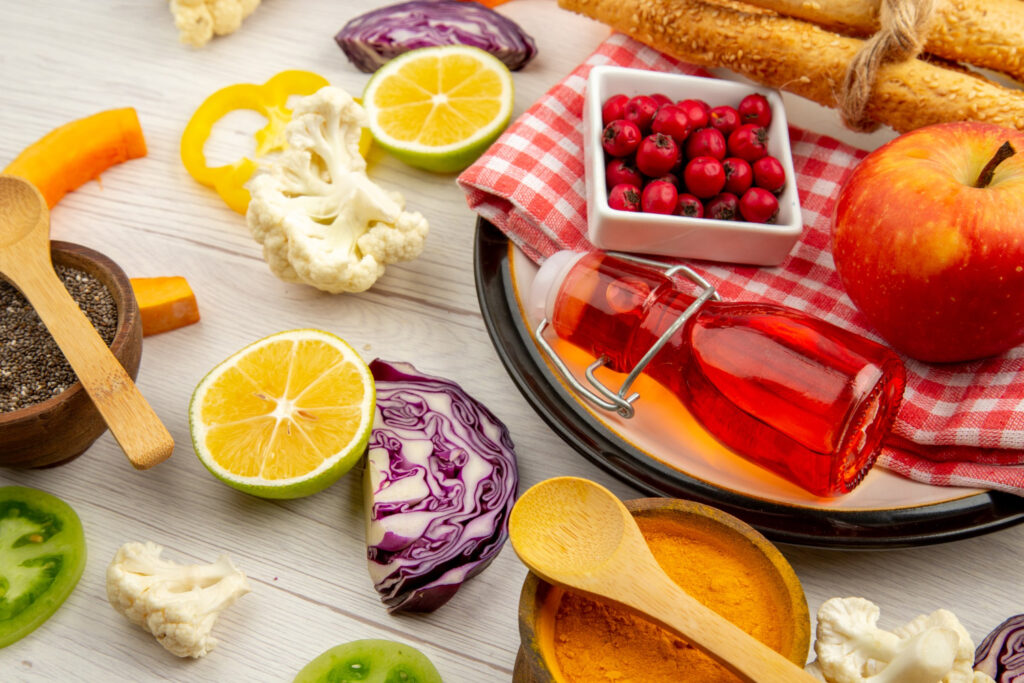
In this article
overview
Inflammation is a natural and essential response by your body to injury or infection. However, when inflammation becomes chronic, it can lead to a host of health problems, including heart disease, diabetes, and various autoimmune disorders. Fortunately, your diet can play a crucial role in managing inflammation. By making thoughtful food swaps, you can reduce your intake of inflammatory foods and increase your consumption of foods that help combat inflammation. This guide will walk you through some of the most effective anti-inflammatory food swaps to help you maintain a healthier lifestyle.
Understanding Inflammatory Foods
Certain foods are known to trigger inflammation in the body, particularly when consumed frequently or in large amounts. These foods include:
- Processed Meats: These meats, such as bacon, sausages, and hot dogs, are high in saturated fats and preservatives, which can promote inflammation.
- Fried Foods: Foods like French fries and doughnuts are often cooked in oils rich in trans fats, which significantly increase inflammation.
- Refined Carbohydrates: White bread, pasta, and pastries lack fiber and essential nutrients, leading to spikes in blood sugar levels that can trigger inflammation.
- Sugary Foods and Beverages: Excess sugar intake is linked to increased inflammation and can contribute to weight gain and other health issues.
- Alcohol: While moderate alcohol consumption might offer some health benefits, excessive drinking is known to exacerbate inflammation.
Anti-Inflammatory Food Swaps
To reduce inflammation and support your overall health, consider making these simple yet effective food swaps:
- Swap Processed Meats for Lean Proteins
- Replace processed meats with lean proteins like chicken, turkey, or plant-based alternatives such as tofu and tempeh. These options are lower in saturated fats and provide essential nutrients without contributing to inflammation.
- Replace Fried Foods with Baked or Grilled Options
- Instead of frying, try baking or grilling your foods. For example, bake your own sweet potato fries or grill vegetables and lean meats. These methods preserve the nutrients in your food while reducing unhealthy fats.
- Choose Whole Grains Over Refined Carbohydrates
- Whole grains like brown rice, quinoa, and oats are rich in fiber and nutrients that help manage blood sugar levels and reduce inflammation. Swap out refined grains like white bread and pasta for their whole-grain counterparts to support better health.
- Opt for Natural Sweeteners
- Instead of refined sugars, use natural sweeteners like honey or maple syrup in moderation. Better yet, satisfy your sweet tooth with fresh fruits, which are naturally sweet and packed with anti-inflammatory antioxidants.
- Moderate Alcohol Consumption
- If you consume alcohol, limit your intake to moderate levels and opt for red wine, which contains resveratrol, an antioxidant that may offer some anti-inflammatory benefits when consumed in moderation.
Types of Anti-Inflammatory Diets
Incorporating anti-inflammatory foods into your diet can be done in various ways, depending on your dietary preferences:
- Mediterranean Diet: This diet emphasizes fruits, vegetables, whole grains, and healthy fats like olive oil. It’s rich in anti-inflammatory foods and has been linked to numerous health benefits, including reduced inflammation.
- DASH Diet: Originally designed to combat hypertension, the DASH diet is similar to the Mediterranean diet but with a stronger emphasis on reducing sodium intake. It includes plenty of fruits, vegetables, and low-fat dairy products.
- MIND Diet: A combination of the Mediterranean and DASH diets, the MIND diet focuses on foods that promote brain health, such as leafy greens, berries, and nuts, while limiting foods that can trigger inflammation.
- Vegetarian and Vegan Diets: These plant-based diets exclude meat and often other animal products, focusing instead on fruits, vegetables, grains, nuts, and seeds. These diets can be highly anti-inflammatory when they emphasize whole, unprocessed foods.
Anti-Inflammatory Foods to Include
In addition to making food swaps, it’s essential to incorporate more anti-inflammatory foods into your diet. Some top choices include:
- Fruits and Vegetables: Rich in antioxidants and polyphenols, colorful fruits and vegetables like berries, leafy greens, and sweet potatoes are excellent for reducing inflammation.
- Nuts and Seeds: Almonds, walnuts, chia seeds, and flaxseeds are packed with healthy fats and anti-inflammatory nutrients.
- Whole Grains: Foods like oats, brown rice, and quinoa are high in fiber, which helps reduce inflammation.
- Healthy Fats: Olive oil, avocado, and fatty fish like salmon are high in omega-3 fatty acids, which are known to combat inflammation.
Anti-Inflammatory Herbs and Spices
Certain herbs and spices are particularly effective in reducing inflammation. Incorporate these into your meals for added health benefits:
- Turmeric: Contains curcumin, a compound with powerful anti-inflammatory effects.
- Ginger: Known for its ability to ease inflammation and reduce pain, particularly in conditions like arthritis.
- Cinnamon: Helps reduce inflammation and lower blood sugar levels.
- Garlic and Onions: Both are rich in anti-inflammatory compounds and have been shown to support overall health.
Anti-Inflammatory Drinks
What you drink can also influence inflammation levels in your body. Consider these beverages for their anti-inflammatory benefits:
- Green Tea: Packed with antioxidants called catechins, green tea is one of the best drinks for reducing inflammation.
- Coffee: Contains polyphenols and other anti-inflammatory compounds, though it should be consumed in moderation to avoid potential negative effects.
- Green Smoothies: Blend leafy greens with fruits like berries for a nutrient-rich, anti-inflammatory drink.
- Water: Staying hydrated is crucial for maintaining overall health and can help manage inflammation.
Tips for Adopting an Anti-Inflammatory Diet
Transitioning to an anti-inflammatory diet doesn’t have to be overwhelming. Start by gradually incorporating more anti-inflammatory foods into your meals and replacing inflammatory items with healthier options. Focus on whole, unprocessed foods, and consider consulting with a nutritionist to tailor the diet to your specific needs.
Potential Risks and Considerations
While an anti-inflammatory diet is generally healthy, there are a few considerations to keep in mind:
- Cost: Fresh fruits, vegetables, and whole foods can be more expensive than processed foods, which may be a barrier for some.
- Preparation Time: Cooking whole foods from scratch requires time and effort, which might be challenging for those with busy schedules.
- Nutrient Deficiencies: If not carefully planned, diets like veganism may lead to deficiencies in certain nutrients. Working with a dietitian can help ensure you get all the necessary nutrients.
- Individual Allergies: Be mindful of any food allergies or sensitivities that could be triggered by anti-inflammatory foods like nuts, whole grains, or fish.
The Takeaway
An anti-inflammatory diet is a powerful tool for promoting health and preventing chronic diseases. By making thoughtful food swaps and incorporating nutrient-dense, whole foods into your diet, you can significantly reduce inflammation and improve your overall well-being. Start small, be consistent, and enjoy the journey toward better health through the power of food
FAQs: Anti-Inflammatory Food Swaps
What are anti-inflammatory food swaps?
Anti-inflammatory food swaps involve replacing foods that trigger inflammation in the body with healthier alternatives that help reduce or prevent inflammation. For example, swapping out processed meats for lean proteins like chicken or tofu can help manage inflammation.
How do anti-inflammatory food swaps benefit my health?
By reducing your intake of inflammatory foods and increasing anti-inflammatory options, you can lower your risk of chronic conditions such as heart disease, diabetes, and arthritis. These swaps also promote better overall health and well-being.
What are some examples of anti-inflammatory food swaps?
Some common anti-inflammatory food swaps include:
- Replacing processed meats with lean proteins like fish or tofu.
- Swapping refined grains like white bread for whole grains such as brown rice or quinoa.
- Choosing baked or grilled foods instead of fried options.
Can I still enjoy sweets on an anti-inflammatory diet?
Yes, you can still enjoy sweets by opting for natural sweeteners like honey or maple syrup in moderation. Additionally, fruits are a great way to satisfy your sweet tooth while providing anti-inflammatory benefits.
Is it necessary to eliminate all inflammatory foods from my diet?
It’s not necessary to completely eliminate all inflammatory foods, but it’s beneficial to limit their consumption and focus on incorporating more anti-inflammatory foods. Balance and moderation are key to maintaining a healthy diet.
What types of diets are considered anti-inflammatory?
Diets such as the Mediterranean, DASH, and MIND diets are considered anti-inflammatory due to their emphasis on fruits, vegetables, whole grains, and healthy fats. These diets promote a balance of nutrients that help reduce inflammation.
Are there any specific herbs and spices that help reduce inflammation?
Yes, certain herbs and spices are known for their anti-inflammatory properties, including turmeric, ginger, cinnamon, garlic, and onions. Incorporating these into your meals can provide additional health benefits.
Can drinks also be anti-inflammatory?
Yes, certain beverages can help reduce inflammation. Green tea, for example, is rich in antioxidants that combat inflammation. Other options include coffee (in moderation), green smoothies, and of course, water, which is essential for overall health.











